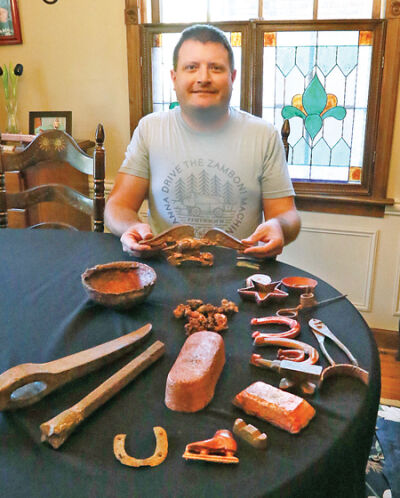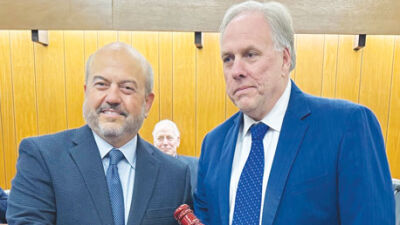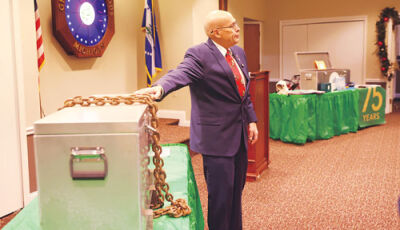
Steve Mouton collects mining items such as things made out of copper as well as rocks and sand from beaches. He is knowledgeable about the history behind “Copper Country.”
Photo by Erin Sanchez
GROSSE POINTE WOODS — Michigan’s Upper Peninsula has a rich mining history which is why one Grosse Pointe Woods resident became fascinated by it almost 20 years ago.
Steve Mouton has had a fascination with mining memorabilia since 2005 when he went on a trip through Western Michigan University. They stayed in Northern Michigan.
“A separate group of us went off into the Keweenaw (Peninsula), Copper Country area, and I just kind of became fascinated,” Mouton said.
Copper Country refers to Michigan’s Upper Peninsula which, according to coppercountry.com, at one time held the world’s largest deposit of copper, where a copper rush occurred in 1843.
“By 1913, 60,000 people lived in Calumet, extracting millions of pounds of copper for Calumet & Hecla Mining Co.,” the website stated. “A failed strike from mining workers and declining demands ended the copper mining era for good in 1968.”
Mouton said most of the items in his collection come from eBay and that his collection has been growing since 2005, though he said collecting has slowed over the years.
“Because, you know, there’s only so much that was made and certain things get more and more expensive,” Mouton said.
He’s always had an interest in history and science.
“Geology is pretty much one subject wrapped in one,” Mouton said. “It’s natural history and science all in one. And I always love when I’m able to go actually see a piece of rock, you know, not in someone’s yard, but sticking out of the ground.”
A couple pieces in Mouton’s collection come from the UP. Companies made a wide variety of pieces including horseshoes, souvenirs, bars and much more.
The more he read and met with people, the more he liked the hobby. Pieces in his collection come from all over, but he’s not too sure of its age because none of it is dated.
“A lot of the bigger mines were active in the early 1900s and started petering off in the 1940s,” Mouton said.
Mouton knows a lot about the history of the mining boom in Michigan including different tragedies within the mining community, how deep the mines went and what tools miners used during that time. He knows many stories about the miners of the era and has experiences from the times he’s visited the mines in Copper Country.
Pictures of Douglass Houghton hang in the cabinet where he keeps his collection. Houghton lived during the nineteenth century and Mouton said he’s the father of the Copper Country. He said a lot of the speculation people of time had was driven by Houghton’s research.
“His efforts on behalf of the State of Michigan contributed greatly to the discovery and subsequent commercial exploitation of copper in Michigan’s Upper Peninsula, as well as an enhanced knowledge of the state’s flora, fauna, and geology,” the Detroit Historical Society’s website said about Houghton.
Mouton said that Houghton explored Michigan by foot. He died by drowning in 1845.
“He never actually saw a working mine,” Mouton said. “He’s the first state geologist of Michigan.”
Mouton said he finds how people started exploring Michigan from scratch fascinating.
“If you’ve ever been to the UP, it’s already isolated as it is. Imagine first showing up,” Mouton said. “Nothing’s there, so they basically had to haul everything by boat to get started.”
Along with mine pieces, Mouton also collects rocks and sand from the beaches he visits.
Mouton said as he learned about the tragedies and figures in mining history, he wondered why they don’t add lessons about these things in schools.
“Why didn’t I know about this until my 20s?” Mouton asked after he explained a story about the Italian Hall disaster in Calumet.
The National Park Service said this in an article about Italian Hall Memorial Park in Calumet.
“During a party here on Christmas Eve of 1913, a false cry of ‘fire’ incited a panic that claimed the lives of over 70 people, many of those children,” the article said.
Mouton said the tragic event happened during a miners strike and that the person who cried fire was allegedly a part of the mining company.
“I think it’s a piece of our history that’s largely untaught and ignored,” Mouton said about mining history.
Mouton said he wants to continue collecting mining artifacts. He said one day he’d consider living in the UP.
“I’m not done,” Mouton said. “I always hope that one day I can start (to) get up to the next levels like the Pewabic or one of the Quincy mine ones.”
 Publication select ▼
Publication select ▼





















